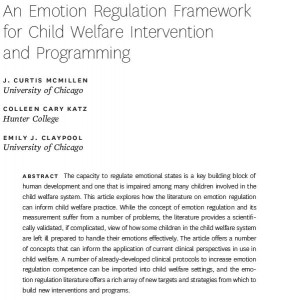Overview of Emotion Regulation
Research and theory on emotion regulation is complex stuff. There is a huge amount of research. It encompasses fields like human development, affective neuroscience and psychological interventions. It is both coalescing and a mess.
With two colleagues, I published an overview of emotion regulation for child welfare services that is a much better overview than you will find on this page.
 But here are what I see as the most important things you need to know from that piece.
But here are what I see as the most important things you need to know from that piece.
1) Emotion regulation refers to efforts to up-regulate or down regulate emotional responses in accordance to what is going on in the moment.
2) We believe that emotion episodes are most often started when we sense that something changed in our environment that alters the odds that a goal that is important to us will be achieved.
3) This process starts automatically in the brain (startle!) and then our emotional responses become more cognitively sculpted in response to questions we (quickly) ask ourselves.
4) Good caregiving when we are young helps us develop the skills for emotion, regulation. They include things like distraction, self-soothing, problem solving to make things better, finding replacement goals for goals that are blocked.
5) Good caregiving also helps us have healthier thoughts about our emotions and emotional situations. Thinking like: this won’t last long, I’ll be able to tolerate this, my emotions make sense, and I’ll be able to figure a way out of this are facilitated by good caregiving.
6) There is a brain science component to this. The ability to access the thinking parts of our brain while we are emotionally hot (sometimes called hot executive functioning) is key to handling intense emotions.
7) All of this means that there are lots of ways to intervene to help someone increase their capacity to handle intense emotions. These include improving the caregiving they receive, helping them think differently about their emotions, increasing their skills to handle intense emotions, and helping them change their brains so that they can access the thinking parts of their brain when emotionally aroused.